- Clinical Technology
- Adult Immunization
- Hepatology
- Pediatric Immunization
- Screening
- Psychiatry
- Allergy
- Women's Health
- Cardiology
- Pediatrics
- Dermatology
- Endocrinology
- Pain Management
- Gastroenterology
- Infectious Disease
- Obesity Medicine
- Rheumatology
- Nephrology
- Neurology
- Pulmonology
Clavus and Squamous Cell Carcinoma
A Photo Quiz to Hone Dermatologic Skills
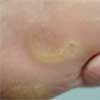
Case 1:
A 49-year-old woman who is receiving immunosuppressive therapy for systemic lupus erythematosus has noticed a tender spot on her foot that she presumes is a plantar wart. She is concerned about the treatment options, given her current medical regimen.
What does this look like to you?
A.
Plantar wart.
B.
Clavus.
C.
Squamous cell carcinoma.
D.
Poroma.
E.
Keratoderma.
(Answer on next page)

Case 1: Because the lesion, when pared, did not reveal any bleeding points, a diagnosis of clavus, B, was made. This hyperkeratotic lesion often results from intermittent mechanical pressure during walking or from the presence of bony prominences. Effective therapy consists of application of a salicylic plaster and cushioning in the form of orthotics or a doughnut pad.
A plantar wart demonstrates dilated capillaries on paring. Squamous cell carcinoma rarely appears on the foot and would present as a nonhealing lesion. Eccrine poromas manifest as erythematous thickenings of the skin.Punctate keratodermas, which usually appear as multiple lesions, are associated with a history of arsenic exposure.
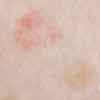
Case 2:
A 79-year-old woman who believes she has eczema on her leg is concerned about an adjacent pigmented lesion that appeared about 6 months ago. She reports that the red spot is tender and the brown spot is asymptomatic.
Can you identify the red spot?
A.
Eczema.
B.
Dermatophyte infection.
C.
Basal cell carcinoma.
D.
Squamous cell carcinoma.
E.
Impetigo.
Can you identify the brown spot?
F.
Lentigo.
G.
Seborrheic keratosis.
H.
Pigmented basal cell carcinoma.
I.
Benign nevus.
J.
Dysplastic nevus.
(Answer on next page.)

Case 2: A biopsy revealed the red spot to be squamous cell carcinoma, D. It was treated with electrodesiccation and curettage. Dermatophyte infections and eczema are pruritic rather than tender. Impetigo has a golden crust. Basal cell carcinoma may be clinically indistinguishable from squamous cell carcinoma but can be ruled out by biopsy.
The brown spot was a seborrheic keratosis, G, which, in its early stages, can mimic a lentigo. A pigmented basal cell carcinoma usually features a pearly surface. Nevi do not demonstrate the verrucoid surfaces or patulous follicles associated with seborrheic keratoses.
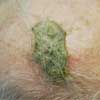
Figure 1
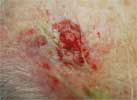
Figure 2
Case 3:
For several months, an 84-year-old man has had a slightly tender crusted lesion on his scalp that bleeds when he picks at it.
What would be an appropriate first step?
A.
Prescribe a shampoo that contains tar, zinc, or selenium.
B.
Prescribe a week of antibiotic therapy for a presumed staphylococcal infection.
C.
Perform cryosurgery for a presumed irritated keratosis.
D.
Remove the crust to see what lies underneath.
E.
Prescribe a course of an oral antifungal agent for a presumed dermatophyte infection.
(Answer on next page.)

Figure 1

Figure 2
Case 3: In this setting, it is best to remove the crust to see what lies underneath, D. This will help determine the most appropriate course of action. A biopsy revealed Bowen disease, which was treated surgically.
Crusted lesions such as this patient's are not caused by dandruff and are not characteristic of keratosis. A staphylococcal infection would be more painful. Dermatophyte infections are highly uncommon in very elderly patients.
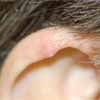
Case 4:
A 43-year-old woman seeks evaluation of a tender nodule on her ear that has been present for several months. The patient has worn her hair short, exposing her ears, for many years. She suspected skin cancer and had scheduled an excision (including general anesthesia) with a plastic surgeon, but decided to seek a second opinion.
What is most prudent course of action?
A.
Advise the patient to keep her surgical appointment.
B.
Perform a biopsy for histologic evaluation.
C.
Perform cryosurgery and have the patient return in 4 weeks if the lesion has not resolved.
D.
Prescribe a trial of 5-fluorouracil for 1 month before considering a biopsy.
E.
Order CT or MRI of the head and neck to check for a primary cancer that has metastasized to the skin.
What is the most likely diagnosis?
F.
Squamous cell carcinoma.
G.
Basal cell carcinoma.
H.
Actinic keratosis.
I.
Sarcoidosis.
J.
Chondrodermatitis nodularis helicis chronica.
(Answer on next page.)

Case 4: A biopsy performed in the office, B, confirmed the diagnosis of chondrodermatitis nodularis helicis chronica, J. This inflammatory lesion of cartilage, which can mimic a skin cancer, responds to cryosurgery or intralesional corticosteroids. Skin cancers are not usually as painful as this lesion, which typically awakens a patient at night. Actinic keratosis may be tender but is not nodular unless it has converted fully to squamous cell carcinoma. Sarcoidosis is generally asymptomatic and features multiple lesions.
